By BETSY TAYLOR
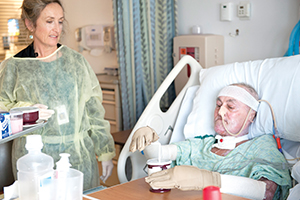
(Photo credit: Jessica Kaminski)
MILWAUKEE — On the night of June 3, 2012, Cedric Jones lit a cigarette, unaware of a natural gas leak in his northwest Milwaukee home. "It was," he says, "a done deal after that." His house exploded. Jones suffered burns to 50 percent of his body including his face. He lost the fingers on his right hand.
Jones was an inpatient at Columbia St. Mary's Regional Burn Center for 144 days. Thirty-five percent of his burns were third degree — a classification for the most severe burn injuries that destroy every layer of skin and may damage blood vessels and nerves. Jones was in a medically induced coma the first months of his treatment. When he regained consciousness: "I just wanted them to let me go. God said that wasn't happening."
He knew what was coming. He'd been burned once before. Although that injury was severe, it was primarily to his arms. Still, his recovery had been so excruciating, Jones said he didn't think he had it in him to go through it again.
Jones, now 57, said his treatments at Columbia St. Mary's were made endurable by the compassion he felt from everyone on the Columbia St. Mary's burn unit, from the housekeeping staff who joked with him to the clinicians who worked to minimize his pain and heal his body and spirit. His treatment included seven skin graft surgeries, wound care, physical and occupational therapy and mental health support, including ongoing involvement in a burn survivors support group.
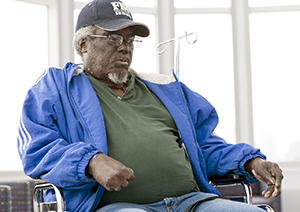
Recovery from his burns has required a series of physical and emotional adjustments. He had to accept his disfigurement, and he had to adjust to changes in his abilities and how others responded to him and his injuries. He has other health issues too. Just recently Jones had a toe amputated as a consequence of poor circulation.
Jones said burn recovery is a lonely experience. Early on, family and friends were afraid to touch him, worried they might hurt him or cause infection. "They didn't know if they could hug me or shake my hand. They acted differently than before, treated me like an invalid," he said.
Because he has limited use of his hands, he requires ongoing assistance with basic activities of daily living, including getting dressed and meal preparation. His daughter and her children moved in with him to help. "It's not that you're in the hospital, and you recover," he says. "It's a whole new way of life."
Standard of care
Columbia St. Mary's Regional Burn Center cares for patients from northern Illinois, Upper Peninsula Michigan and the eastern half of Wisconsin. More than 120 U.S. burn centers including Columbia St. Mary's fill a critical role in caring for burn patients and those with other severe skin injuries. (See sidebar.) More than 60 percent of severely burned patients are admitted to U.S. hospitals with specialized burn centers, according to the American Burn Association, an organization of clinicians, hospitals and first responders.
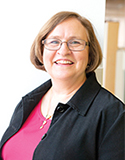

Darlene Sargent, the Columbia St. Mary's Regional Burn Center manager, said burn centers certified by the American Burn Association follow guidelines established by that association in consultation with the American College of Surgeons' Committee on Trauma. Those guidelines cover everything from the roles and responsibilities of personnel to requirements for emergency and surgical services, infection control and more.
Columbia St. Mary's opened its dedicated burn unit 55 years ago, and it is the fourth oldest in the United States. It has 12 beds, and it is one of two burn centers in Wisconsin certified by the American Burn Association in care of adult burn patients. Columbia St. Mary's is part of St. Louis-based Ascension Health.
Patient stays vary from a day to a year, with an average length of two weeks, Sargent said.
Expert care
Dr. Nicholas Meyer, the medical director of Columbia St. Mary's Regional Burn Center, said an advantage of burn centers is that patients, who often have complicated internal and external injuries, are treated by clinicians with specific expertise in closing open burn wounds as well as managing the pain, the infection risk and the scarring that come with severe burns. Burn surgeons at Columbia St. Mary's are adept at skin graft techniques including the use of human, animal or artificial skin or bioengineered products that use the patient's own cells to grow skin for grafts. Burn center clinicians use high-tech bandages and specific techniques to change dressings to minimize pain and reduce the risk of infection, a major concern with burn patients. Staff and visitors don sterile gowns and sanitize their hands before and after each visit to a patient's room.
Money and mission
Care for burn patients is expensive because it is intense and specialized, explained Tim Waldoch, the medical center's interim chief financial officer and chief business development officer. Patients interviewed for this story said their insurance had covered the bulk of their costs. Waldoch said generally burn care is one of the more profitable service lines at Columbia St. Mary's, though the margin varies based on the patients' insurance, also known as the payer mix.
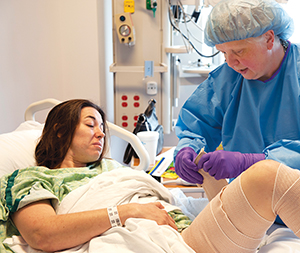
(Photo credit: Jessica Kaminski)
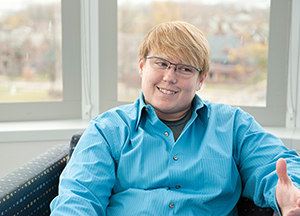
Sargent said, at Columbia St. Mary's, caring for burn patients is part of its mission to care for the vulnerable. She added that many burn patients are permanently disabled by their injuries and require ongoing support and assistance.
Body image
Along with the scars, invisible wounds can linger long after the critical stage of physical recovery. Jones said it took him months to really look at himself in a mirror, something he could only do after he went to an out-of-town conference for burn survivors. "I didn't like people staring at me, and I couldn't look at myself," he said. He drew strength from spending time with others who had survived burns, and worked to accept his own image.
At Columbia St. Mary's, experienced staff know a patient's new appearance after burns and surgery hits many patients and their loved ones at their core. Training for new nurses includes a lesson that before patients see a mirror, they see their nurses' faces. Nurses must be aware of what their expression communicates to patients as they provide care.
Nurse Carol Bork, who has worked at the hospital for 38 years including 35 at the burn unit, recalled the words of Dr. George Collentine, a former medical director of the center, who used to say: "If you can't find the person inside, you shouldn't be here, because you have to treat the person, not the burn."
Bork and Melissa Kersten, a burn unit nurse practitioner and co-coordinator of the patient support group Survivors Offering Assistance in Recovery, said before family or friends visit a burn patient, they try to prepare them for physical changes in the person's appearance, or unpleasant smells they may encounter in the patient's room.
Learning to adapt
Former patients at Columbia St. Mary's Regional Burn Center credit the support group for burn patients as helping them accept and adapt to their injuries.
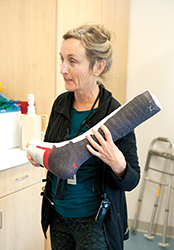
Elaina Meier is a former patient who considers the caring staff and support of other patients as vital to her own progress. Now 33 and a resident of Madison, Wis., she was a 19-year-old working at a summer camp when a co-worker setting up for a camp project came through a doorway carrying two gallons of boiling water and boiling wax. The two collided and Meier was scalded. She sustained second and third degree burns, primarily to her upper body, torso and right arm. She got out of the hospital as soon as she could because she longed to restore a sense of normalcy to her life. She returned for follow-up surgeries as her recovery progressed.
"I needed to heal my head before I could let the docs heal my body," she said. The extent of Meier's injuries aren't evident when she's dressed in street clothes. She said that's often described as being a patient who recovered from "hidden" burns. She had eight surgeries, including skin grafting, reconstruction work, scar revision and wound management and has ongoing nerve issues from the injury.
Meier said the support group helped her combat some of the isolation she felt as a hospital patient and offered a measure of hope during her healing process. "No matter where you are in your journey, there's someone a few steps ahead of you, and you can follow their lead in your journey," she said. She continues to participate in the support group, but now she does so as a student clinician.
Meier, a former high school teacher now working on a Ph.D. in counseling psychology, volunteers about two days a week at the hospital, including her time facilitating the patient support group. She said there are differences in how injury and recovery play out in the lives of patients.
"We're really careful not to compete in our suffering. Anyone who has made it onto a burn unit has suffered. We want to honor that."
| Protocol for care of burns and injuries |
Burns that require specialized care in a burn facility:
Other injuries treated at Columbia St. Mary's Regional Burn Center:
Source: Columbia St. Mary's Regional Burn Center |
